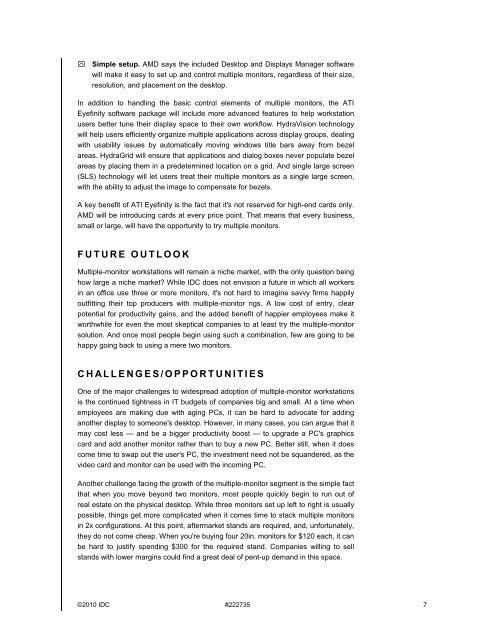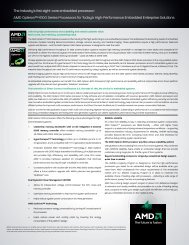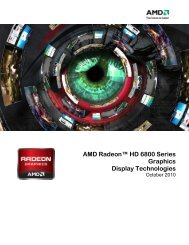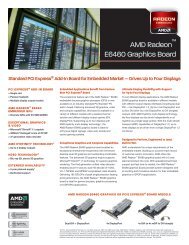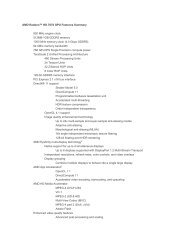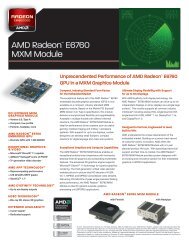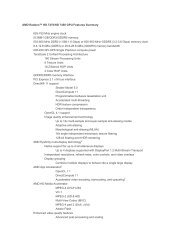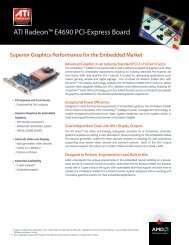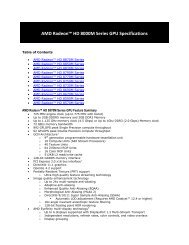WHITE PAPER - AMD
WHITE PAPER - AMD
WHITE PAPER - AMD
You also want an ePaper? Increase the reach of your titles
YUMPU automatically turns print PDFs into web optimized ePapers that Google loves.
! Simple setup. <strong>AMD</strong> says the included Desktop and Displays Manager software<br />
will make it easy to set up and control multiple monitors, regardless of their size,<br />
resolution, and placement on the desktop.<br />
In addition to handling the basic control elements of multiple monitors, the ATI<br />
Eyefinity software package will include more advanced features to help workstation<br />
users better tune their display space to their own workflow. HydraVision technology<br />
will help users efficiently organize multiple applications across display groups, dealing<br />
with usability issues by automatically moving windows title bars away from bezel<br />
areas. HydraGrid will ensure that applications and dialog boxes never populate bezel<br />
areas by placing them in a predetermined location on a grid. And single large screen<br />
(SLS) technology will let users treat their multiple monitors as a single large screen,<br />
with the ability to adjust the image to compensate for bezels.<br />
A key benefit of ATI Eyefinity is the fact that it's not reserved for high-end cards only.<br />
<strong>AMD</strong> will be introducing cards at every price point. That means that every business,<br />
small or large, will have the opportunity to try multiple monitors.<br />
FUTURE OUTLOOK<br />
Multiple-monitor workstations will remain a niche market, with the only question being<br />
how large a niche market? While IDC does not envision a future in which all workers<br />
in an office use three or more monitors, it's not hard to imagine savvy firms happily<br />
outfitting their top producers with multiple-monitor rigs. A low cost of entry, clear<br />
potential for productivity gains, and the added benefit of happier employees make it<br />
worthwhile for even the most skeptical companies to at least try the multiple-monitor<br />
solution. And once most people begin using such a combination, few are going to be<br />
happy going back to using a mere two monitors.<br />
CHALLENGES/OPPORTUNITIES<br />
One of the major challenges to widespread adoption of multiple-monitor workstations<br />
is the continued tightness in IT budgets of companies big and small. At a time when<br />
employees are making due with aging PCs, it can be hard to advocate for adding<br />
another display to someone's desktop. However, in many cases, you can argue that it<br />
may cost less — and be a bigger productivity boost — to upgrade a PC's graphics<br />
card and add another monitor rather than to buy a new PC. Better still, when it does<br />
come time to swap out the user's PC, the investment need not be squandered, as the<br />
video card and monitor can be used with the incoming PC.<br />
Another challenge facing the growth of the multiple-monitor segment is the simple fact<br />
that when you move beyond two monitors, most people quickly begin to run out of<br />
real estate on the physical desktop. While three monitors set up left to right is usually<br />
possible, things get more complicated when it comes time to stack multiple monitors<br />
in 2x configurations. At this point, aftermarket stands are required, and, unfortunately,<br />
they do not come cheap. When you're buying four 20in. monitors for $120 each, it can<br />
be hard to justify spending $300 for the required stand. Companies willing to sell<br />
stands with lower margins could find a great deal of pent-up demand in this space.<br />
©2010 IDC #222735 7


